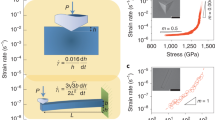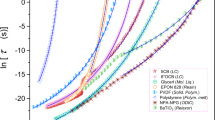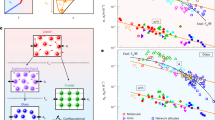Abstract
The nature of the transformation by which a supercooled liquid ‘freezes’ to a glass—the glass transition—is a central issue in condensed matter physics1,2,3 but also affects many other fields, including biology4. Substantial progress has been made in understanding this phenomenon over the past two decades, yet many key questions remain. In particular, the factors that control the temperature-dependent relaxation and viscous properties of the liquid phase as the glass transition is approached (that is, whether the glass-forming liquid is ‘fragile’ or ‘strong’5,6,7) remain unclear. Here we show that the fragility of a glass-forming liquid is intimately linked to a very basic property of the corresponding glass phase: the relative strength of shear and bulk moduli, or Poisson's ratio.
This is a preview of subscription content, access via your institution
Access options
Subscribe to this journal
Receive 51 print issues and online access
$199.00 per year
only $3.90 per issue
Buy this article
- Purchase on Springer Link
- Instant access to full article PDF
Prices may be subject to local taxes which are calculated during checkout



Similar content being viewed by others
References
Anderson, P. W. Through a glass lightly. Science 267, 1615 (1995)
Angell, C. A. Formation of glasses from liquids and biopolymers. Science 267, 1924–1935 (1995)
Debenedetti, P. G. & Stillinger, F. H. Supercooled liquids and the glass transition. Nature 410, 259–267 (2001)
Fox, K. C. Putting proteins under glass. Science 267, 1922–1923 (1995)
Nemilov, S. V. The kinetics of elementary processes in the condensed state. II. Shear relaxation and the equation of state for solids. Zh. Fiz. Khim. 42, 1391–1396 (1968); Russ. J. Phys. Chem. 42, 726–731 (1968)
Nemilov, S. V. Thermodynamic and kinetic aspects of the vitreous state (CRC Press, Boca Raton, 1995)
Angell, C. A. Spectroscopy simulation and scattering, and the medium range order problem in glass. J. Non-Cryst. Solids 73, 1–17 (1985)
Sokolov, A. P., Rössler, E., Kisliuk, A. & Quitmann, D. Dynamics of strong and fragile glassformers: differences and correlation with low-temperature properties. Phys. Rev. Lett. 71, 2062–2065 (1993)
Scopigno, T., Ruocco, G., Sette, F. & Monako, G. Is the fragility of a liquid embedded in the properties of its glass? Science 302, 849–852 (2003)
Buchenau, U. & Wischnewski, A. Fragility and compressibility at the glass transition. Preprint at http://arXiv.org/cond-mat/0401088(2004).
Bordat, P., Affouard, F., Descamps, M. & Ngai, K. L. Does the interaction potential determine both the fragility of a liquid and the vibrational properties of its glassy state? Preprint at http://arXiv.org/cond-mat/0401117 (2004).
Roland, C. M. & Casalini, R. Temperature dependence of local segmental motion in polystyrene and its variation with molecular weight. J. Chem. Phys. 119, 1838–1842 (2003)
Barrer, R. M. The viscosity of pure liquids. I. Non-polymerised fluids. Trans. Faraday Soc. 39, 48–59 (1943)
Stickel, F., Fischer, E. W. & Richert, R. Dynamics of glass-forming liquids. II. Detailed comparison of dielectric relaxation, dc-conductivity, and viscosity data. J. Chem. Phys. 104, 2043–2055 (1996)
Tobolsky, A., Powell, R. E. & Eyring, H. in Frontiers in Chemistry (eds Burk, R. E. & Grummit, O.) Vol. 1, 125 (Interscience, New York, 1943)
Dyre, J. C. & Olsen, N. B. Landscape equivalent of the shoving model. Phys. Rev. E 69, 042501–042504 (2004)
Wang, W. H., Wen, P., Zhao, D. Q., Pan, M. X. & Wang, R. J. Relationship between glass transition temperature and Debye temperature in bulk metallic glasses. J. Mater. Res. 18, 2747–2751 (2003)
Sanditov, D. S., Sangadiev, S. Sh. & Kozlov, G. V. On the correlation between elastic modulus of vitreous solids and glass transition temperature of melts. Glass Phys. Chem. 24, 539–547 (1998)
Fabelinsky, I. L. Molecular Scattering of Light Ch. VII (Plenum, New York, 1968)
Sokolov, A. P. et al. Low-temperature anomalies in strong and fragile glass formers. Phys. Rev. Lett. 78, 2405–2408 (1997)
Courtens, E., Foret, M., Hehlen, B. & Vacher, R. The vibrational modes of glasses. Solid State Commun. 117, 187–200 (2001)
Grigera, T. S., Martin-Mayor, V., Parisi, G. & Verrocchio, P. Phonon interpretation of the ‘boson peak’ in supercooled liquids. Nature 422, 289–292 (2003)
Malinovsky, V. K. & Sokolov, A. P. The nature of boson peak in Raman spectra in glasses. Solid State. Comm. 57, 757–761 (1986)
Duval, E., Boukenter, A. & Achibat, T. Vibrational dynamics and the structure of glasses. J. Phys. Condens. Matt. 2, 10227–10234 (1990)
Soltwisch, M., Quitmann, D. & Ruocco, G. On the connection between low frequency vibrational and relaxational motion in glasses. J. Non-Cryst. Solids 203, 12–18 (1996)
Novikov, V. N. Vibration anharmonicity and fast relaxation in the region of glass transition. Phys. Rev. B 58, 8367–8378 (1998)
Martinez, L.-M. & Angell, C. A. A thermodynamic connection to the fragility of glass-forming liquids. Nature 410, 663–667 (2001)
Rössler, E., Hess, K.-U. & Novikov, V. N. Universal representation of viscosity in glass forming liquids. J. Non-Cryst. Solids 223, 207–222 (1998)
Acknowledgements
This work was supported by NSF and REFI grants.
Author information
Authors and Affiliations
Corresponding author
Ethics declarations
Competing interests
The authors declare that they have no competing financial interests.
Supplementary information
Supplementary Table 1
The value of parameters used in the paper in Figures 1–3, Supplementary Figure 1, and respective references. In this table, the transversal and longitudinal sound velocities in glassy state, the high temperature activation energy of shear viscosity, fragility index, the amplitude of the boson peak, and glass transition temperature of some glass formers are shown. (DOC 70 kb)
Supplementary Figure 1
Correlation between the boson peak amplitude normalized to the Debye density of states, Abp, with the ratio of longitudinal and transversal sound velocities found at high frequencies in the glassy state. (DOC 200 kb)
Rights and permissions
About this article
Cite this article
Novikov, V., Sokolov, A. Poisson's ratio and the fragility of glass-forming liquids. Nature 431, 961–963 (2004). https://doi.org/10.1038/nature02947
Received:
Accepted:
Issue Date:
DOI: https://doi.org/10.1038/nature02947
This article is cited by
-
Atomistic study of liquid fragility and spatial heterogeneity of glassy solids in model binary alloys
NPG Asia Materials (2023)
-
Hot dense silica glass with ultrahigh elastic moduli
Scientific Reports (2022)
-
Disentangling structural and kinetic components of the α-relaxation in supercooled metallic liquids
Communications Physics (2022)
-
Evaluation of Poisson’s ratio for thin soft material by multiplex procedure of spherical indentation mechanics
International Journal of Mechanics and Materials in Design (2022)
-
Low melting oxide glasses prepared at a melt temperature of 500 °C
Scientific Reports (2021)
Comments
By submitting a comment you agree to abide by our Terms and Community Guidelines. If you find something abusive or that does not comply with our terms or guidelines please flag it as inappropriate.



